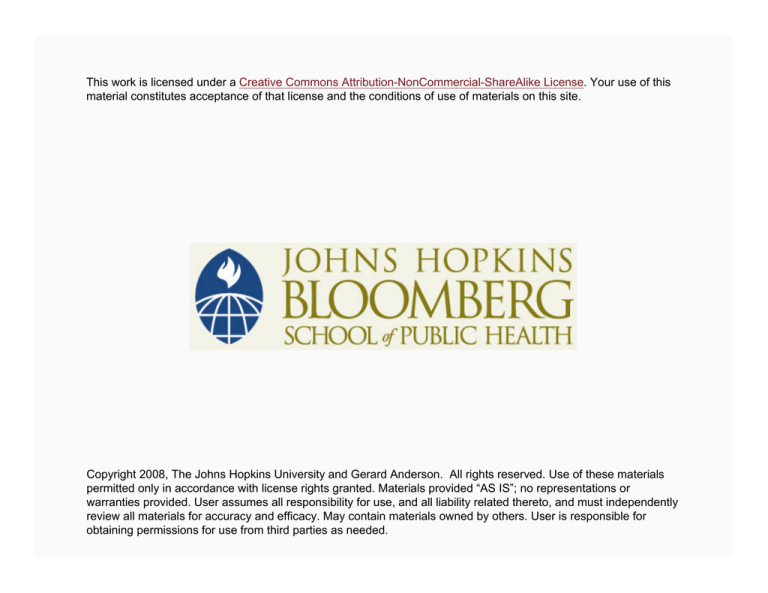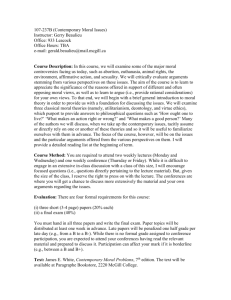
This work is licensed under a Creative Commons Attribution-NonCommercial-ShareAlike License. Your use of this
material constitutes acceptance of that license and the conditions of use of materials on this site.
Copyright 2008, The Johns Hopkins University and Gerard Anderson. All rights reserved. Use of these materials
permitted only in accordance with license rights granted. Materials provided “AS IS”; no representations or
warranties provided. User assumes all responsibility for use, and all liability related thereto, and must independently
review all materials for accuracy and efficacy. May contain materials owned by others. User is responsible for
obtaining permissions for use from third parties as needed.
Historical, Legal, and Ethical Perspectives on Public
Health Policy
Gerard F. Anderson, PhD
Johns Hopkins University
Overview
Public health orientation
Public health law
History of public health regulation
Ethical issues in public health
3
Section A
Population Basis of Public Health
Populations/Individuals
Orientation of public health is to the health of populations
Orientation of medical care is to the health of individuals
5
Domain of Public Health
What is the domain of public health?
What are public health issues?
6
Population Based Perspective
“Public health is oriented toward the analysis of the
determinants of health and disease on the population basis,
while medicine is oriented toward individual patients.”
− Elizabeth Fee
7
Population Based Perspective
“Public health services are those shared by all members of the
community, organized and supported by, and for the benefit
of, the people as a whole.”
− Larry Gostin
8
Population Based Perspective
“Public health is what we, as a society, do collectively to
assure the conditions for people to be healthy.”
− IOM
9
Blurry Lines between Public Health and Medical Care for
Certain Issues
Health insurance coverage
Health care spending
Health care policy
10
One of the Criterion in the Eight Step Model Is Often Legality
Is the proposed change legal?
What is the legal basis for public health?
11
Tradeoffs in Public Health Law
Improved health vs. autonomy, privacy, and other individual
rights
− Which takes priority?
12
Stem Cell Research
Role of scientific investigation vs. sanctity of life
− Which has priority?
− What is the basis for your opinion?
13
Section B
Public Health Law
Public Health Law-Definition
“Public health law is the study of the legal powers and duties
of the state to assure the conditions for people to be healthy
(e.g., to identify, prevent, and ameliorate risks to health in the
population) and the limitations on the power of the state to
constrain the autonomy, privacy, liberty, proprietary, or other
legally protected interests of individuals for the protection or
promotion of community health.”
− Gostin, “A Theory and Definition of Public Health Law,”
p. 4
15
Five Components of Public Health Law
1.
2.
3.
4.
5.
Role of government
Power to assure compliance
Public concerns
Direct service provision
Relationship between government and public
16
Role of Government in Public Health
What is legal basis for public health in federal law
“We the people of the United States, in order to form a more
perfect union, establish justice, insure domestic tranquility,
provide for the common defense, promote the general
welfare, and secure the blessings of liberty to ourselves and
our posterity, do ordain and establish this constitution….”
− Preamble to the Constitution
17
Promote the General Welfare
How much authority can be drawn from those four words?
Who should interpret the general welfare?
When do other provisions in the Constitution take
precedence?
18
Government Public Health Regulation—Historical
Perspective
1700-2006—gradual increase in government’s role in public
health
Continual debate over when the public welfare is more
important than individual rights
Continual debate over improved health or individual
freedoms
− Improved health gradually winning
19
Government Public Health Regulation—1700s and 1800s
Travel at sea
Quarantines
Inoculations
Food inspections
Garbage control
20
Additional Roles—1900s
Sanitary movement
− Response to epidemics
Surveys of health conditions
Regulation of food, sewage, water, etc.
21
Additional Roles—Early 20th Century
State boards of health
Bacteriology
Disease reporting
Food and drug administration
22
Additional Roles—Late 20th Century
Greater regulation of private sector
National Institutes of Health established
Air and water quality standards (EPA)
Limited tobacco advertising
Communicable disease reporting
Pesticide production
Consumer product safety
Occupational health and safety
23
Government Health Regulation in the 21st Century
What additional public health roles will be needed?
What about the IOM report?
Which of these items are highest priority?
24
Section C
Legal Issues in Public Health
What Are the Legal Issues in Public Health?
When should government act to promote community health?
When should government protect individual freedoms?
26
Are these the Core Functions of Public Health?
Prevent epidemics
Protect against environmental hazards
Promote healthy behaviors
Respond to disasters
Assure quality of health services
27
Are these the Essential Functions of Public Health?
Monitor community health status
Investigate health problems
Educate the public about health
Enforce health and safety protections
Fund research
Assure competent workforce
28
Tradeoffs
When is it acceptable to compromise on the core functions
and essential roles of public health?
29
Ethics and Public Policy
Laws and regulations can be influenced by ethical concerns
Ethical concerns can influence policy debates
30
Moral Constraints versus Public Policy
How do moral constraints differ from the criteria used to
evaluate public policies?
31
Ethics
The term used to describe various ways of examining the
moral life
The systematic study of morality
− Beauchamp and Childress (2001)
32
Morality
Morality is the term used to describe those set of beliefs
concerning right and wrong human conduct which are so
widely shared as to form a stable consensus
− Common morality—norms that bind all persons in all
places
− Community-specific moralities—norms which are
binding upon members of particular religions, cultures, or
professions
X Beauchamp and Childress (2001)
33
Moral Goals of Public Health
Producing benefits
Avoiding/minimizing harms
Maximizing benefits over harms
34
General Moral Considerations
We consider two general types of moral considerations in
public health
− Those that relate directly to the goals of public health
− More general considerations which serve as constraints
on what we can do to achieve the goals of public health
X Childress, et al. (2002)
35
Resource Allocation
Policy is about resource allocation
Opportunity costs
− Alternative ways to allocate resources
36
Principles of Distributive Justice
Strict Egalitarianism
− Every person should have exactly the same level of
material goods or services
Utilitarianism
− Resources distributed in a way that maximizes the welfare
of all the people
Dessert-Based Principle
− Resources distributed to those people who deserve
certain benefits or rights in light of their actions
(contribution, effort, or need for compensation)
Difference Principle
− Resources to be distributed in a way that the leastadvantaged people receive the maximum possible gain
37
Question
What should be the principle for allocating public health
services?
38
Individual Rights vs. Collective Good
Smoking
Drinking
Toxic waste
Ergonomics
Seat belts
Gun ownership
39
Moral Dilemmas
Moral Dilemmas exists when . . .
− There are good moral arguments which dictate that one
do action “X” AND there are good moral arguments which
dictate that one NOT do action “X” BUT arguments on
either side do not clearly outweigh the others
− There are good moral arguments which require that one
do action “X” AND good moral arguments which require
that one do action “Y” BUT circumstances are such that
you cannot do both AND the arguments for one do not
clearly outweigh the arguments for the other
X Beauchamp and Childress (2001)
40
Moral Dilemmas versus Policy Debates
What are the similarities?
What are the differences?
41
A General Strategy for Public Health Ethics Analysis
Identify the ethical problem
Assess the available facts relevant to the problem
Identify stakeholders
Identify the values at stake
Identify the available options
Consider the process and values pertaining to process
Notes Available
42
Section D
Application: Medicare Modernization Act of 2003
Example of Political/Legal Issue
Medicare Modernization Act of 2003
− Also known as the Prescription Drug Bill
− Designed to give health and prescription drug benefits to
Medicare recipients in 2006
44
Medicare Modernization Act of 2003: Background
Medicare passed in 1965 without prescription drug coverage
Private sector and Medicaid have drug coverage
Strong push by elderly for drug coverage
45
Situation in 2003
Medicare going broke
Republicans believe fundamental reform is necessary
Limited ($400 billion over 10 years) amount of money is
available
46
Legislation Passes
Minor reforms to Medicare program
Substantial payments to hospitals, managed care plans, and
rural providers
Prescription drug coverage with significant gaps in coverage
and no controls over pharmaceutical spending
47
1. Define the Problem—Political Debate
Republicans need to defend legislation
Democrats need to criticize legislation
48
Define the Problem—Policy
High drug prices needed to support pharmaceutical research
and development
Drug benefits insufficient
49
2. Assemble Some Evidence
How much more does the U.S. pay for prescription drugs?
Do gaps in coverage make a difference?
50
Relative Prices of Pharmaceuticals
Relative prices of 30 pharmaceuticals in 4 countries (2003)
20% US
Discount
1.2
1.00
Price Index
1.0
0.8
0.66
0.60
0.6
0.52
0.4
0.2
0.0
United States
Canada
France
United Kingdom
51
Medicare Spending on Drugs
Spending on Medicare prescription drug benefits in 2006
Total drug
spending
(billions)
Medicare
Out-ofpocket
Third-party
payers
A. Current
legislation
101.9
44.5
31.0
26.4
B. Alternative
benefit
73.6
44.5
19.1
9.9
52
Current and Alternative Out-of-Pocket Medicare Costs
Reduction in out-of-pocket costs under current
and alternative Medicare drug benefits, by number
of chronic conditions
Mean reduction in o-o-p
spending
$1,200
$1,000
Current Legislation
Alternative Benefit
$800
$600
C
$400
$200
$0
0
1
2
3
4 or more
Number of chronic conditions
53
3. Construct the Alternatives
Do nothing
Price controls
Discount cards
Reimportation
54
4. Select the Criterion
Political contributions
− AARP
− Pharma
Votes of seniors
Access to existing pharmaceuticals
New drug development
55
5. Project the Outcomes
Do Nothing
Price Controls
Discount Cards
Reimportation
AARP
––
?
+
+
Pharma
++
––
+
–
Votes of seniors
––
?
?
++
Access to
pharmaceuticals
0
++
+
+
++
––
0
–
Drug
development
56
6. Confront the Trade-offs
Which constituency is more important—AARP or Pharma?
Which concern (access or research and development) is most
important?
57
7. Decide
58
8. Tell Your Story
Access to pharmaceuticals
for Medicare beneficiaries
New medicines/new hope
59









